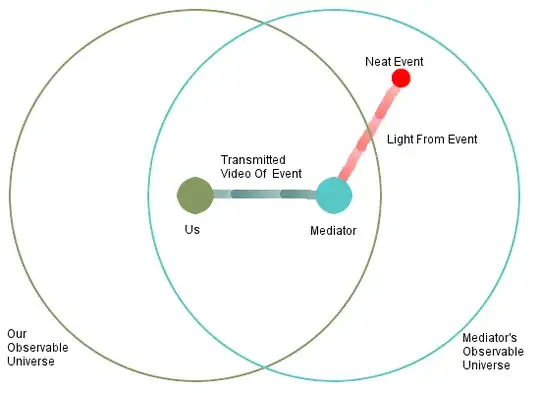I have mixed intuitions about this.
On one hand, nothing can travel faster than the speed of light and if there is enough space between you and an event then a signal will get stuck in the middle of nowhere traversing an ever-expanding void.
But, on the other hand, it seems reasonable enough that we could share information with other distant observers. That coupled with the fact that every observer has their own observable universe centered on them suggests to me that it would be possible to transmit an account of an event that another observer could never experience firsthand. While the information would have to travel farther than the radius of an observable universe, no individual particle would have to.
Would we be able to learn about something outside our observable universe if someone sent us pictures of, for example, the cosmic background radiation of their observable universe? Is this even a possibility?
Edit: To clarify, I'm talking about an observable universe limited by the Future horizon caused by the expansion of space and not the Particle horizon caused by how far particles could have traveled given the age of the universe. As it stands right now, a mediator wouldn't be able to see anything novel since, as HDE226868 points out, our Particle horizon would have expanded to encompass the event by the time their forwarded signal would have reached us.
Edit2: Several answers have stated that any mediator would have been taken outside of our observable universe by the time it was able to transmit anything novel. But, is that going to always be the case? I was under the impression that gravity was sufficient to counteract the expansion of space to bind galaxies together. Is it unreasonable to suppose the existence of a mediator that has the appropriate velocity and acceleration to maintain a constant position relative to us for an arbitrary length of time despite the expansion of space?
Perhaps the movement of such an object has a relativistic effect on its observable universe?
Edit3: I think I figured out a good lead. While the Particle horizon is a ball around every observer and based on particles just not having had enough time to travel, the Future horizon is based on redshift which in turn is based on relative velocity among other things.
$$1 + z = \sqrt{\frac{1 + \frac{v}{c}}{1 - \frac{v}{c}}}$$
This suggests to me that two observers at a fixed position relative to each other (i.e. https://xkcd.com/1522/) will have the same Future horizon due to the Doppler effect. However, there seems to be some room to reduce redshift back from infinity with some engineering.
For instance, a telescope in orbit around a planet would be able to see farther while pointing prograde than anyone on the planet since its relative velocity to distant events would be lower and signals would be blueshifted back up from infinity. This actually seems to suggest that a mediator could peer beyond our Future horizon for us.
However, there are some other factors that go into redshift other than the Doppler effect. Gravity wells and the expansion of space also have an effect. But, would these other effects frustrate this scenario?
